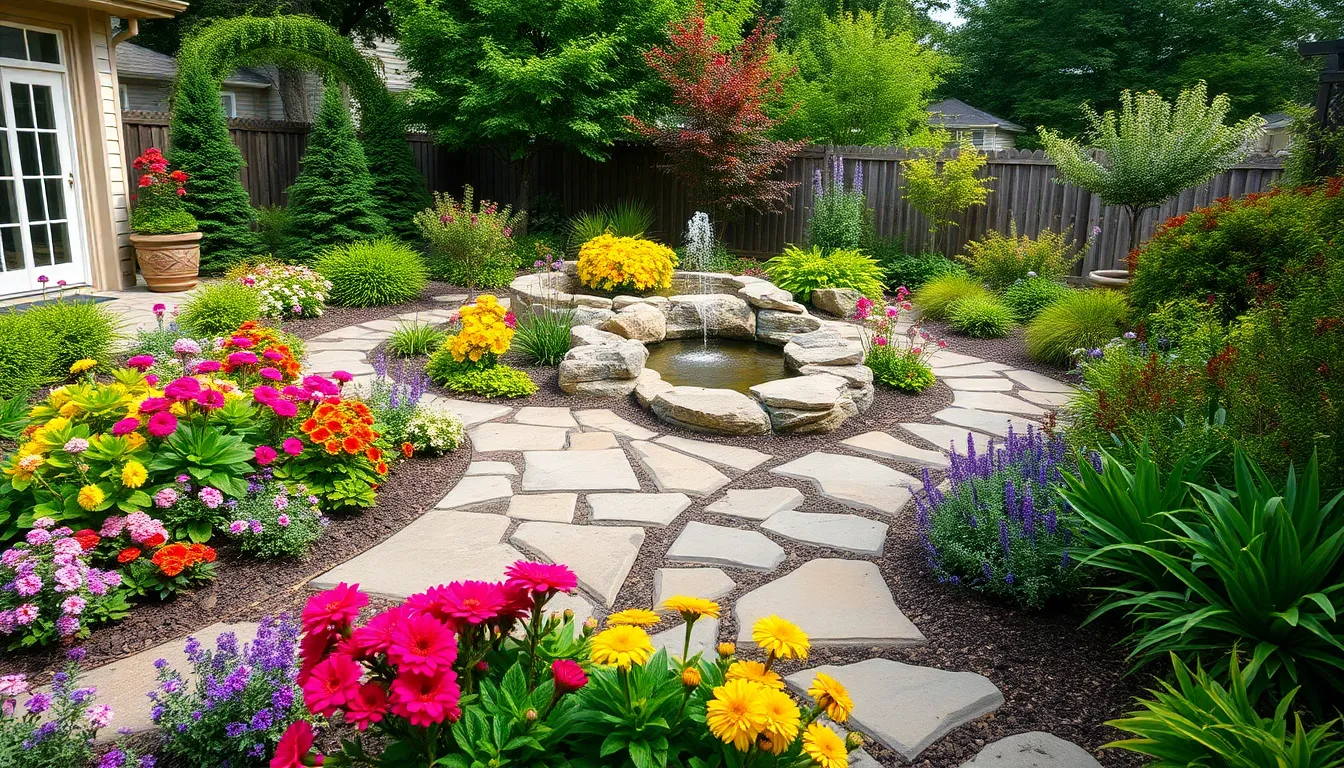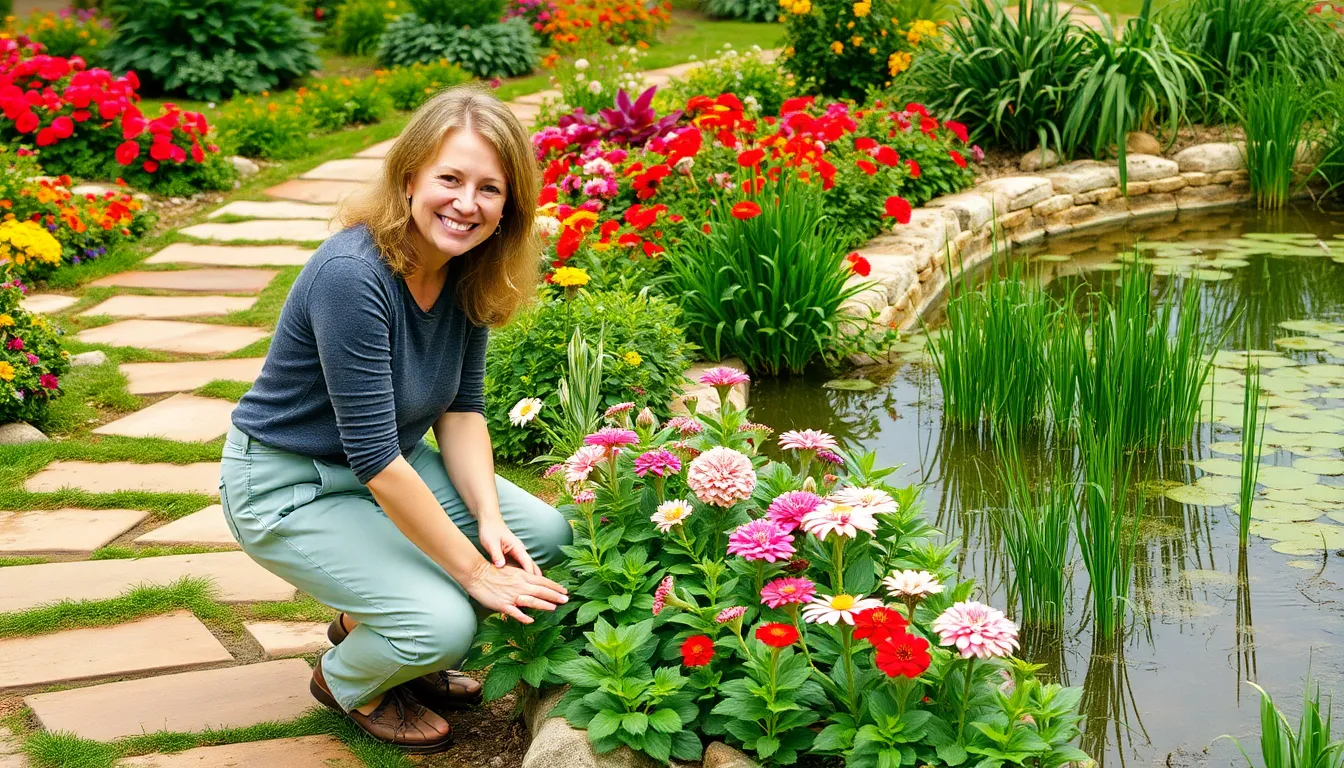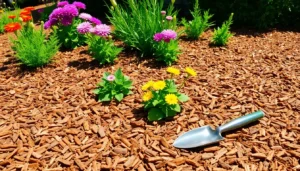Transforming an outdoor space into a stunning landscape isn’t just for the pros with fancy tools and an endless budget. With a little creativity and a splash of elbow grease, anyone can turn their yard into a paradise that even Mother Nature would envy. Imagine sipping your morning coffee surrounded by vibrant flowers and lush greenery instead of staring at that patch of weeds that’s been judging you for months.
Table of Contents
ToggleOverview of Outdoor Landscaping
Outdoor landscaping involves designing and enhancing outdoor spaces to create aesthetically pleasing environments. People use greenery, flowers, paths, and structures to turn a simple yard into a vibrant and welcoming area. Consideration of local climate and soil type influences plant selection and placement. Successful landscaping integrates elements like color, texture, and seasonal changes, providing visual appeal year-round.
Key components include plants, hardscaping materials, and water features. Plants enhance beauty and provide habitat for wildlife. Hardscaping includes walkways, patios, and retaining walls, creating functional outdoor spaces. Incorporating water features, like ponds or fountains, adds tranquility and attracts birds, enhancing the overall experience.
Sustainability also plays a major role in modern outdoor landscaping. Implementing native plants reduces water usage and maintenance efforts. Xeriscaping, or drought-resistant landscaping, focuses on minimizing water consumption while maintaining aesthetic appeal. Strategic planting of trees and shrubs can provide shade, lowering energy costs.
Planning a successful outdoor landscape involves assessing available space and defining purpose. Whether it’s for relaxation, entertainment, or gardening, understanding requirements helps tailor the design. Creating zones within the yard can improve organization and functionality.
Ultimately, outdoor landscaping combines vision, creativity, and effort. Individuals can achieve stunning transformations by choosing appropriate elements while considering environmental factors. Engaging in this process can lead to a personal sanctuary, allowing families to enjoy nature in their own backyards.
Benefits of Outdoor Landscaping

Outdoor landscaping offers numerous advantages that enhance both the environment and the aesthetic appeal of outdoor spaces. Vibrant, well-designed landscapes provide a welcoming atmosphere and can significantly increase property value.
Aesthetic Appeal
A thoughtfully designed outdoor landscape introduces color and texture. Blooming flowers, lush greenery, and ornamental features create visual interest. Unique pathways and patios invite exploration and enjoyment. Seasonal plantings ensure beauty throughout the year. Integrating various elements, such as boulders and water features, adds depth to any space. Changing colors and scents engage the senses, creating a serene atmosphere that encourages relaxation and enjoyment.
Environmental Impact
Landscaping promotes biodiversity by providing habitats for local wildlife, including birds and pollinators. Utilizing native plants conserves water and supports the local ecosystem. Landscapes absorb carbon dioxide and release oxygen, improving air quality. Proper landscaping contributes to soil erosion prevention and offers shade that reduces urban heat. Rainwater can be harvested through specific designs, which aids in sustainable water management. Thoughtful landscaping practices enhance the environment while creating beautiful spaces for everyone to enjoy.
Key Elements of Outdoor Landscaping
Outdoor landscaping incorporates various elements that enhance functionality and visual appeal within outdoor spaces. Understanding both hardscaping and softscaping is essential for creating a balanced environment.
Hardscaping
Hardscaping includes all non-plant elements. These features comprise pathways, patios, decks, and walls. Durable materials such as stone, brick, and concrete support longevity. Incorporating benches or fire pits facilitates outdoor gatherings. The design of hardscaping should complement existing structures and work harmoniously with softscaping. Proper planning ensures functional use of space, providing enjoyable areas for relaxation and recreation.
Softscaping
Softscaping refers to the living components in landscaping. Plants, trees, and flowers contribute life and color to outdoor areas. Selecting native species promotes sustainability, as these plants require less water and maintenance. Incorporating a mix of perennials and annuals ensures seasonal diversity. Ground cover helps prevent soil erosion, while shrubs add visual texture. Together, softscaping enhances the beauty of hardscaped features, creating a cohesive outdoor environment.
Common Outdoor Landscaping Styles
Outdoor landscaping features various styles that cater to different aesthetic preferences and functional needs. Each style incorporates unique elements and design principles, promoting an engaging outdoor experience.
Modern Landscaping
Modern landscaping emphasizes clean lines, minimalism, and functional designs. Incorporating geometric shapes and open spaces defines this approach, while elements such as concrete patios and metal sculptures provide contemporary appeal. Low-maintenance plants characterize modern landscapes, featuring varieties such as succulents and ornamental grasses. Utilizing a limited color palette, designers create cohesive environments that showcase the beauty of simplicity. Furthermore, sustainable practices often integrate into modern designs through the use of drought-resistant plants and smart irrigation systems, enhancing both aesthetic and ecological value.
Rustic Landscaping
Rustic landscaping celebrates natural beauty and organic materials. This style often showcases native plants, wildflowers, and trees, evoking a sense of connection to the outdoors. Incorporating natural stones and reclaimed wood, rustic designs create warm, inviting spaces. Paths made from gravel or stepping stones enhance the charm of rustic landscapes while blending seamlessly with the surrounding environment. Water features like small ponds or natural streams often complement this style, attracting wildlife and promoting relaxation. Ultimately, rustic landscaping prioritizes harmony with nature, creating tranquil retreats that resonate with an earthy aesthetic.
Tips for Successful Outdoor Landscaping
Successful outdoor landscaping involves several key practices that ensure a beautiful and sustainable design. Assess the space before starting a project; knowing the dimensions and existing features helps in planning effectively. Identify the primary purpose of the landscape, whether for relaxation, entertainment, or gardening, guiding decisions on plant placement and features.
Choose the right plants based on local climate and soil type. Native plants not only thrive in the local environment but require less water and maintenance, making them ideal for sustainable landscaping. Incorporate a mix of perennials and annuals to create seasonal interest and ensure vibrant colors throughout the year.
Design hardscaping elements to complement softscaping. Paths, patios, and walls enhance functionality while providing structure to the landscape. Select durable materials, such as stone and concrete, for longevity and compatibility with the natural surroundings.
Consider incorporating water features, such as ponds or fountains, to attract wildlife and add tranquility to the outdoor space. These elements create soothing sounds and provide habitats for various species.
Sustainability plays an essential role in successful landscaping. Employ xeriscaping techniques to minimize water usage; this approach maintains beauty without heavy irrigation. Rainwater harvesting systems can further enhance water management and promote eco-friendly practices.
Utilize color, texture, and seasonal changes to create visual interest. Group plants in clusters to achieve a natural look; this method tends to be more appealing than solitary plants scattered throughout the area. Maintain the landscape regularly through pruning, weeding, and fertilizing to promote healthy growth.
Integrating these tips helps transform an outdoor space into a stunning environment that reflects personal style while supporting local ecosystems.
Outdoor landscaping is an opportunity for anyone to create a personal oasis that enhances both beauty and functionality. With a thoughtful approach to design and plant selection, individuals can cultivate vibrant spaces that reflect their style while supporting the environment. By considering elements like hardscaping and softscaping, along with sustainable practices, it’s possible to develop a landscape that thrives year-round.
The joy of transforming an outdoor area lies in the creativity and effort invested. Whether it’s a serene garden or an inviting entertainment space, the potential for stunning landscapes is limitless. Embracing the process not only improves the aesthetic appeal but also contributes positively to local ecosystems and property value.







